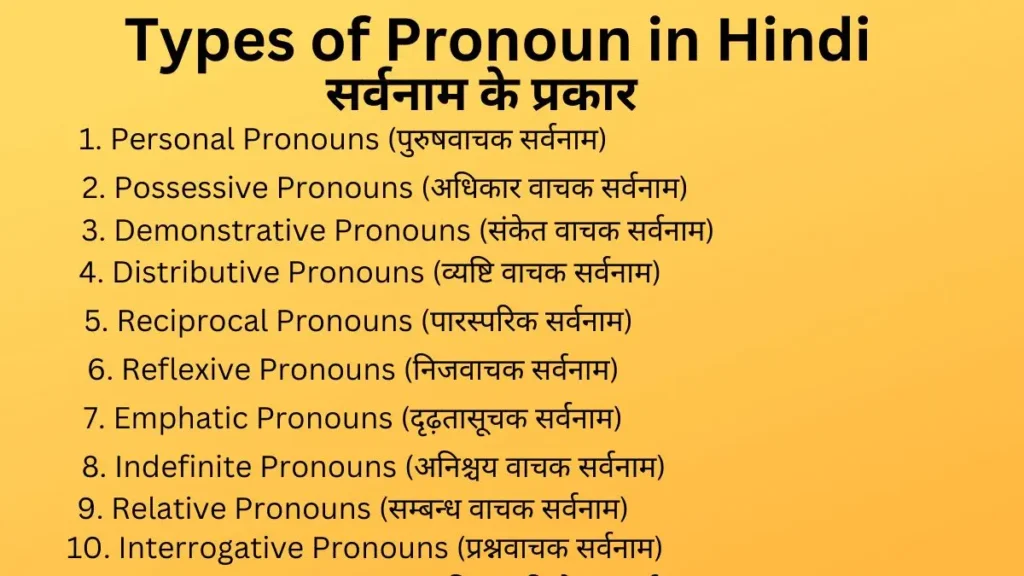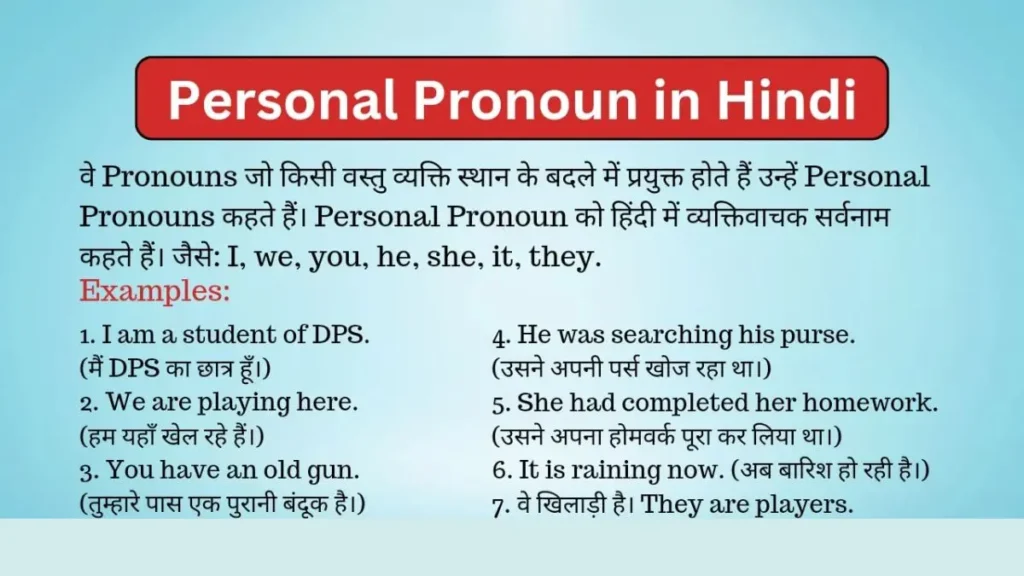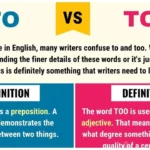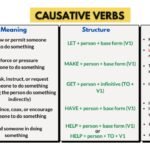Personal Pronoun In Hindi: Pronoun in Hindi: दोस्तों, आप सभी का स्वागत है हमारे इस पोस्ट में, इस पोस्ट में हमने Pronoun की परिभाषा, उदहारण के साथ-साथ उसके रूल के बारे में भी विस्तार से बताया है| यदि आप कोई प्रतियोगिता परीक्षा की तैयारी कर रहे है तो यह पोस्ट आपको बहुत ही ज्यादा मदद करने वाली है| हमें उम्मीद है कि इस पोस्ट को अंत तक पढ़ने के बाद आपका Pronoun से जुड़े सादे डाउट ख़तम हो जायेंगे|
Pronoun in Hindi
Pronoun in Hindi ( सर्वनाम की परिभाषा): सर्वनाम वह शब्द है जिसका प्रयोग संज्ञा के स्थान पर किया जाता है|
Definition of Pronoun: A pronoun is a word used at the place of noun.
Example: He, She, It, They etc.
- मैं – I – मैं बहुत खुश हूँ| – I am very happy.
- तुम – You (informal) – तुम कहाँ हो? – Where are you?
- वह – He/She/It – वह एक अच्छा व्यक्ति है। – He/She/It is a good person.
- खुद – Oneself/Itself – वह अपने खुद को सजाने में व्यस्त था। – He was busy decorating himself.
- कोई – Someone/Anyone – क्या कोई यहाँ है? – Is someone here?
- कुछ – Something – मुझे कुछ खाने का मन है। – I feel like eating something.
- कोई भी – Anyone/Anything – आप कोई भी काम कर सकते हैं| – You can do anything.
- हम – We – हम एक साथ खेल रहे थे| – We were playing together.
- आप – You (formal/plural) – आप कैसे हैं| – How are you?
- वे – They – वे अच्छे दोस्त हैं| – They are good friends.
Personal Pronouns को पहचानने के नियम-
Personal Pronouns एकवचन (Singular) और बहुवचन (Plural) में आते हैं। एकवचन में ‘I’ (मैं), ‘you’ (तुम/आप), ‘he’ (वह), ‘she’ (वह), ‘it’ (यह/वह), और बहुवचन में ‘we’ (हम), ‘you’ (तुम सब/आप सब), और ‘they’ (वे) होते हैं।
Meaning of Pronoun in Hindi
Pronoun को हिंदी में ‘सर्वनाम’ कहते हैं| सर्वनाम का प्रयोग नाउन के बदले में किया जाता है|
Meaning of Pronoun – सर्वनाम
Pronunciation of Pronoun – प्रोनाउन
Kind/Type of Pronoun in Hindi
आप सभी को बता दे कि Pronoun मुख्यत: 10 प्रकार के होते है| जिसके बारे में हमने नीचे विस्तार से बताया है|
PRIDE RID PR (प्राईड रीड पी आर)
- P – Personal Pronoun
- R – Reflexive Pronoun
- I – Indefinite Pronoun
- D – Demonstrative Pronoun
- E – Emphatic Pronoun
- R – Relative Pronoun
- I – Interrogative Pronoun
- D – Distributive Pronoun
- P – Possessive Pronoun
- R – Reciprocal Pronoun
Personal Pronoun
Personal Pronoun तीन व्यक्तियों का बोध कराता है| 1st Person, 2nd Person तथा 3rd Parson नीचे दिए गए टेबल की मदद से आप आसानी से समझ सकते है| साथ ही आप इसे समझने के लिए फैक्ट्स को भी पढ़ सकते हैं|
Personal pronoun is a stand of three person:
| Persons | Subjective Case | Passive Case | Objective Case |
| 1st | I, We | My/mine, Our/ours | Me, Us |
| 2nd | You | Your/Yours | You |
| 3rd | He, She, It, They, One | His, Her/Hers, There/There’s, Ones | Him, Her, It, Them, One |
Deferent Between Prosomal Pronoun And Reflexive Pronoun in Hindi
व्यक्तिवाचक सर्वनाम (Personal Pronoun)
व्यक्तिवाचक सर्वनाम वे सर्वनाम होते हैं जो किसी व्यक्ति, वस्तु, या जानवर का सीधा उल्लेख करते हैं। ये सर्वनाम वाक्य में कार्यकर्ता (Subject) या कर्म (Object) के रूप में प्रयोग होते हैं।
Examples:
- मैं (I)– मैं एक किताब पढ़ता हूँ। (I read a book.)
- तुम (You)– तुम स्कूल जाते हो। (You go to school.)
- वह (He/She/It)– वह खेल खेलता है। (He plays a game.)
- हम (We)– हम पार्क में दौड़ते हैं। (We run in the park.)
- वे (They)– वे सिनेमा देखते हैं। (They watch a movie.)
आत्मवाचक सर्वनाम (Reflexive Pronoun)
आत्मवाचक सर्वनाम वे सर्वनाम होते हैं जो वाक्य में क्रिया का प्रभाव खुद पर ही लौटाते हैं। यह दिखाते हैं कि क्रिया का प्रभाव उसी व्यक्ति या वस्तु पर पड़ता है जो क्रिया कर रहा है।
Examples:
- स्वयं (Myself)- मैं स्वयं को आईने में देखता हूँ। (I see myself in the mirror.)
- खुद (Yourself)- तुम खुद को सुरक्षित रखो। (You keep yourself safe.)
- खुद (Himself/Herself/Itself)– वह खुद को तैयार करता है। (He prepares himself.)
- स्वयं (Ourselves)- हम स्वयं को खुश रखते हैं। (We keep ourselves happy.)
- खुद (Yourselves)- हम स्वयं को खुश रखते हैं। (We keep ourselves happy.)
- स्वयं (Themselves)- वे खुद को प्रशिक्षित करते हैं। (They train themselves.)
Prosomal Pronoun And Reflexive Pronoun में अंतर
| Point | व्यक्तिवाचक सर्वनाम (Personal Pronoun) | आत्मवाचक सर्वनाम (Reflexive Pronoun) |
|---|---|---|
| परिभाषा | किसी व्यक्ति, वस्तु, या जानवर का सीधा उल्लेख करता है। | क्रिया का प्रभाव उसी व्यक्ति या वस्तु पर होता है जो क्रिया कर रहा है। |
| उपयोग | कार्यकर्ता (Subject) या कर्म (Object) के रूप में। | जब क्रिया का प्रभाव खुद पर ही हो। |
| उदाहरण | I, You, He, She, It, We, They | Myself, Yourself, Himself, Herself, Itself, Ourselves, Yourselves, Themselves |
| हिंदी उदाहरण | मैं, तुम, वह, हम, वे | स्वयं, खुद, खुद, स्वयं, खुद, स्वयं |

Fact (1)
If different kinds of person come together in a same sentence are a arranged to two three one (231) order. – यदि विभिन्न प्रकार के व्यक्ति एक ही वाक्य में एक साथ आते हैं तो इसे दो तीन एक (231) क्रम में व्यवस्थित किया जाता है।
Example: I, Ram and you performed well in exam. – मैंने, राम और आपने परीक्षा में अच्छा प्रदर्शन किया।
Note (i) 23 –
Example: Ram and you performed well in exam. (x) / You and Ram performed well in exam. (✓)
उदाहरण: राम और आपने परीक्षा में अच्छा प्रदर्शन किया। (x) / आपने और राम ने परीक्षा में अच्छा प्रदर्शन किया। (✓)
Note (ii) 31
Example: I and Ram performed well in exam. (x)/ Ram and i performed well in exam. (✓)
उदाहरण: मैंने और राम ने परीक्षा में अच्छा प्रदर्शन किया। (x) / राम और मैंने परीक्षा में अच्छा प्रदर्शन किया। (✓)
Note (iii) 21
Example: I and you performed well in exam. (x) / You and i performed well in exam. (✓)
उदाहरण: मैंने और आपने परीक्षा में अच्छा प्रदर्शन किया। (x) / आपने और मैंने परीक्षा में अच्छा प्रदर्शन किया। (✓)
Examples :
- Incorrect: I, Sita, and you are attending the meeting.
- Correct: You, Sita, and I are attending the meeting.
- Hindi: आपने, सीता और मैंने बैठक में भाग लिया।
- Incorrect: I, Raj, and you will visit the museum tomorrow.
- Correct: You, Raj, and I will visit the museum tomorrow.
- Hindi: आपने, राज और मैंने कल संग्रहालय का दौरा करेंगे।
- Incorrect: I, Shyam, and you have completed the project.
- Correct: You, Shyam, and I have completed the project.
- Hindi: आपने, श्याम और मैंने परियोजना को पूरा कर लिया है।
- Incorrect: I, John, and you need to discuss this matter.
- Correct: You, John, and I need to discuss this matter.
- Hindi: आपको, जॉन और मुझे इस मुद्दे पर चर्चा करनी है।
- Incorrect: I, the manager, and you should approve the plan.
- Correct: You, the manager, and I should approve the plan.
- Hindi: आपको, प्रबंधक और मुझे योजना को मंजूरी देनी चाहिए।
Fact (2)
If different type of person come together and the accept to guilt or are plural , are arranged into ‘One Two Three’ (123) order. – यदि विभिन्न प्रकार के व्यक्ति एक साथ आते हैं और अपराध स्वीकार करते हैं या बहुवचन होते हैं, तो उन्हें ‘एक दो तीन’ (123) क्रम में व्यवस्थित किया जाता है।
Example: Ram, i and you where going to kill Mohan. (x) / I, you and Ram where going to kill Mohan. (✓)
उदाहरण: राम, मैं और तुम मोहन को मारने वाले हैं। (x) / मैं, तुम और राम कहां मोहन को मारने जा रहे हैं। (✓)
- Incorrect: Sita, I, and you broke the vase.
- Correct: I, you, and Sita broke the vase.
- Hindi: मैंने, तुमने और सीता ने फूलदान तोड़ा।
- Incorrect: John, I, and you lied to the teacher.
- Correct: I, you, and John lied to the teacher.
- Hindi: मैंने, तुमने और जॉन ने शिक्षक से झूठ बोला।
- Incorrect: He, I, and you missed the deadline.
- Correct: I, you, and he missed the deadline.
- Hindi: मैंने, तुमने और उसने समयसीमा चूक गए।
- Incorrect: They, I, and you were late.
- Correct: I, you, and they were late.
- Hindi: मैं, तुम और वे देर से आए।
- Incorrect: I, he, and you failed the test.
- Correct: I, you, and he failed the test.
- Hindi: मैंने, तुमने और उसने परीक्षा में असफल रहे।
- Incorrect: Ram, I, and you stole the money.
- Correct: I, you, and Ram stole the money.
- Hindi: मैंने, तुमने और राम ने पैसे चुराए।
Fact (3)
If different kinds of persons come together and first person is also representing then get there joined person from (we, our, ours) group. – यदि विभिन्न प्रकार के व्यक्ति एक साथ आते हैं और पहला व्यक्ति भी प्रतिनिधित्व कर रहा है तो वहां (हम, हमारे, हमारे) समूह से व्यक्ति को शामिल करें|
Example: You, Ram and i high performed your duty honestly (x) / You, Ram and i high performed our duty honestly. (✓)
उदाहरण: आपने, राम और मैंने अपना कर्तव्य ईमानदारी से निभाया। (x) / आपने, राम और मैंने अपना कर्तव्य ईमानदारी से निभाया। (✓)
- Incorrect: You, Ram, and I high performed your duty honestly.
- Correct: You, Ram, and I performed our duty honestly.
- Hindi: आपने, राम और मैंने अपना कर्तव्य ईमानदारी से निभाया।
- ncorrect: You, the manager, and I will present your report.
- Correct: You, the manager, and I will present our report.
- Hindi: आपने, प्रबंधक और मैंने अपनी रिपोर्ट प्रस्तुत करेंगे।
- Incorrect: You, Sita, and I have finished your project on time.
- Correct: You, Sita, and I have finished our project on time.
- Hindi: आपने, सीता और मैंने अपना प्रोजेक्ट समय पर पूरा किया।
- Incorrect: You, the team, and I need to submit your assignments.
- Correct: You, the team, and I need to submit our assignments.
- Hindi: आपने, टीम और मुझे अपने असाइनमेंट जमा करने की आवश्यकता है।
- Incorrect: You, Priya, and I should improve your skills.
- Correct: You, Priya, and I should improve our skills.
- Hindi: आपने, प्रिया और मैंने अपनी कौशल को सुधारना चाहिए।
Fact (4)
If different type of persons come together and 1st person in not presenting name get there joined personal form you group(you, your, you). – यदि विभिन्न प्रकार के व्यक्ति एक साथ आते हैं और पहला व्यक्ति नाम प्रस्तुत न करने पर आपके समूह (आप, आप, आप) में व्यक्तिगत रूप से शामिल हो जाता है|
Example: You and Ram have performed his duty honestly. (x) / You and Ram have performed your duty honestly. (✓)
उदाहरण: आपने और राम ने अपना कर्तव्य ईमानदारी से निभाया है। (x) / आपने और राम ने अपना कर्तव्य ईमानदारी से निभाया है। (✓)
You and Ram most denoted whatever be can. (x)/ You and Ram most denoted whatever you can. (✓)
आपने और राम ने जो कुछ भी हो सकता था उसका सबसे अधिक निरूपण किया। (x) / आपने और राम ने जो कुछ भी आप कर सकते हैं उसका सबसे अधिक निरूपण किया। (✓)
Incorrect: You and Sita completed her project successfully.
- Correct: You and Sita completed your project successfully.
- Hindi: आपने और सीता ने अपना प्रोजेक्ट सफलतापूर्वक पूरा किया।
Incorrect: You and the manager need to submit his reports.
- Correct: You and the manager need to submit your reports.
- Hindi: आपको और प्रबंधक को अपनी रिपोर्ट जमा करने की आवश्यकता है।
Incorrect: You and John have shown his dedication.
- Correct: You and John have shown your dedication.
- Hindi: आपने और जॉन ने अपनी प्रतिबद्धता दिखाई है।
Incorrect: You and Priya should improve her skills.
- Correct: You and Priya should improve your skills.
- Hindi: आपको और प्रिया को अपनी कौशल को सुधारना चाहिए।
Incorrect: You and the team achieved its goals.
- Correct: You and the team achieved your goals.
- Hindi: आपने और टीम ने अपने लक्ष्य हासिल किए।

Some Uses of ‘It’
(i) ‘It’ comes to show a singular non-living thing.– ‘यह’ शब्द एक विलक्षण निर्जीव वस्तु को दर्शाता है।
Example:
- I have a pen, it is very society.
- मेरे पास एक किताब है, यह बहुत अच्छी है।- I have a book, it is very good.
- मुझे एक कार मिली, यह बहुत तेज है।- I got a car, it is very fast.
- वह एक घर है, यह बहुत बड़ा है।- That is a house, it is very big.
- यह एक पेड़ है, यह बहुत ऊँचा है।- This is a tree, it is very tall.
- मेरे पास एक कंप्यूटर है, यह बहुत पुराना है।- I have a computer, it is very old.
- मेरे पास एक फूल है, यह बहुत सुंदर है।- I have a flower, it is very beautiful.
- वह एक पुल है, यह बहुत लंबा है।- That is a bridge, it is very long.
- मेरे पास एक घड़ी है, यह बहुत महंगी है।- I have a watch, it is very expensive.
- यह एक फर्नीचर है, यह बहुत आरामदायक है।- This is a piece of furniture, it is very comfortable.
- मेरे पास एक बैग है, यह बहुत भारी है।- I have a bag, it is very heavy.
(ii) ‘It’ comes to show an animal.– ‘यह’ एक जानवर को दिखाने के लिए आता है।
Example:
- I have a dog, it is red.
- मेरे पास एक बिल्ली है, यह बहुत प्यारी है।- I have a cat, it is very cute.
- मेरे पास एक घोड़ा है, यह बहुत तेज है।- I have a horse, it is very fast.
- मेरे पास एक खरगोश है, यह बहुत छोटा है।- I have a rabbit, it is very small.
- मेरे पास एक पक्षी है, यह बहुत रंगीन है।- I have a bird, it is very colorful.
- मेरे पास एक मछली है, यह बहुत सुंदर है।- I have a fish, it is very beautiful.
- मेरे पास एक गाय है, यह बहुत दूध देती है।- I have a cow, it is very milky.
- मेरे पास एक हाथी है, यह बहुत बड़ा है।- I have an elephant, it is very big.
- मेरे पास एक मेंढक है, यह बहुत हरा है। -I have a frog, it is very green.
- मेरे पास एक बंदर है, यह बहुत चंचल है।- I have a monkey, it is very playful.
- मेरे पास एक चीता है, यह बहुत तेज दौड़ता है।- I have a cheetah, it is very fast.
(iii) ‘It’ comes to introduce a natural rule or event.– ‘यह’ एक प्राकृतिक नियम या घटना को प्रस्तुत करने के लिए आता है।-
Example:
- It is raining now. / It is Monday today.
- अब बारिश हो रही है।- It is raining now.
- आज सोमवार है।- It is Monday today.
- यहाँ बहुत ठंड है।- It is very cold here.
- वहाँ बहुत गर्मी है।- It is very hot there.
- आज तेज हवा चल रही है।- It is windy today.
- सुबह का समय हो गया है।- It is morning now.
- अब शाम हो गई है।- It is evening now.
- रात का समय हो गया है।- It is night now.
- अभी धूप निकली है।- It is sunny now.
- अभी धुंध है।- It is foggy now.
(iv) ‘It’ comes to show a little baby. ‘यह’ एक छोटे बच्चे को दिखाने के लिए आता है।
Example:
- I have a nephew, it is very knotty.
- मेरे पास एक भतीजा है, यह बहुत प्यारा है।- I have a nephew, it is very cute.
- मेरे पास एक बच्चा है, यह बहुत चंचल है।- I have a baby, it is very playful.
- वह मेरा भतीजा है, यह बहुत हँसमुख है।- That is my nephew, it is very cheerful.
- मेरे पास एक नवजात शिशु है, यह बहुत छोटा है।- I have a newborn, it is very small.
- मेरे पास एक बच्चा है, यह बहुत नटखट है।- I have a baby, it is very naughty.
- वह मेरा बच्चा है, यह बहुत शांत है।- That is my child, it is very calm.
- मेरे पास एक बच्चा है, यह बहुत नटखट है।- I have a baby, it is very mischievous.
- वह मेरा भतीजा है, यह बहुत प्यारा है।- That is my nephew, it is very adorable.
- मेरे पास एक बच्चा है, यह बहुत शरारती है।- I have a baby, it is very naughty.
- वह मेरा बच्चा है, यह बहुत शांत है।- That is my baby, it is very quiet.
(v) ‘It’ comes to make a pre-statement about something. – ‘यह’ किसी चीज़ के बारे में पूर्व-कथन करने के लिए आता है।
Example:
- It is right that honesty is the host policy.
- यह सही है कि ईमानदारी सबसे अच्छी नीति है।- It is right that honesty is the best policy.
- यह सच है कि मेहनत का फल मीठा होता है।- It is true that hard work pays off.
- यह अच्छा है कि तुमने अपनी पढ़ाई पूरी कर ली।- It is good that you completed your studies.
- यह दुखद है कि वे हार गए।- It is sad that they lost.
- यह खुशी की बात है कि वे जीत गए।- It is happy that they won.
- यह संभव है कि वह आ सकता है।- It is possible that he may come.
- यह महत्वपूर्ण है कि हम समय पर पहुँचे।- It is important that we arrive on time.
- यह अनिवार्य है कि आप नियमों का पालन करें।- It is mandatory that you follow the rules.
- यह आश्चर्यजनक है कि उसने यह कर दिखाया।- It is surprising that he did it.
- यह उचित है कि वह अपना काम पूरा करे।- It is fair that he completes his work.
Personal pronoun In Affirmative Sentence
- I am reading a book.-मैं एक किताब पढ़ रहा हूँ।
- You are very talented.-तुम बहुत प्रतिभाशाली हो।
- He goes to school every day.-वह हर दिन स्कूल जाता है।
- She loves to dance.-वह नृत्य करना पसंद करती है।
- It is a sunny day.-यह एक धूप वाला दिन है।
- We enjoy playing soccer.-हम फ़ुटबॉल खेलना पसंद करते हैं।
- They are going to the market.-वे बाजार जा रहे हैं।
- He has a new bicycle.-उसके पास एक नई साइकिल है।
- We are planning a trip.-हम एक यात्रा की योजना बना रहे हैं।
- You did a great job.-आप ने बहुत अच्छा काम किया।
Personal pronoun In Negative Sentence
- I do not like spicy food.
- You should not play with matches.
- He does not speak Spanish fluently.
- She will not attend the meeting tomorrow.
- It is not raining outside.
- We did not receive your email yesterday.
- You should not worry about the exam.
- They do not agree with the new policy.
- It does not matter which movie we watch.
- We will not go to the beach if it rains.
Personal pronoun In Interrogative Sentence
- क्या मैं आ सकता हूँ? (Can I come?)
- तुम क्यों रो रहे हो? (Why are you crying?)
- उसने कहा क्या? (What did he say?)
- क्या वह तुम्हें पसंद करती है? (Does she like you?)
- हम कहाँ जा रहे हैं? (Where are we going?)
- तुमने क्या खाया? (What did you eat?)
- क्या उसने तुम्हें देखा? (Did he see you?)
- वे कब आएंगे? (When will they come?)
- उन्होंने कहा क्या? (Did they say anything?)
- क्या तुम्हें उससे बात करनी है? (Do you want to talk to him?)
frequently Asked Question Of Personal Pronoun In Hindi
1.What is a personal pronoun? पर्सनल प्रोनाउन क्या होता है?
Answer (उत्तर): पर्सनल प्रोनाउन वाक्य में व्यक्ति या वस्तु के स्थान पर प्रयुक्त होता है, जैसे ‘I’, ‘you’, ‘he’, ‘she’, ‘it’, ‘we’, ‘they’।
2. How many types of personal pronouns are there? पर्सनल प्रोनाउन कितने प्रकार के होते हैं?
Answer (उत्तर): पर्सनल प्रोनाउन तीन प्रकार के होते हैं: एकवचन (singular), बहुवचन (plural), और संबंधवाचक (reflexive)।
3. What are the singular personal pronouns in English? अंग्रेजी में एकवचन पर्सनल प्रोनाउन क्या होते हैं?
Answer (उत्तर): अंग्रेजी में एकवचन पर्सनल प्रोनाउन ‘I’ (मैं), ‘you’ (तुम/आप), ‘he’ (वह), ‘she’ (वह), ‘it’ (यह) होते हैं।
4. Can you give examples of plural personal pronouns?- बहुवचन पर्सनल प्रोनाउन के उदाहरण दे सकते हैं?
Answer (उत्तर): बहुवचन पर्सनल प्रोनाउन जैसे ‘we’ (हम), ‘you’ (तुम/आप), ‘they’ (वे) होते हैं।
5. How do you use ‘he’ and ‘she’ in sentences?- वाक्य में ‘he’ और ‘she’ का प्रयोग कैसे करते हैं?
Answer (उत्तर): ‘he’ वाक्य में पुरुष व्यक्ति के लिए और ‘she’ महिला व्यक्ति के लिए प्रयुक्त होते हैं, जैसे “He is my brother.” (वह मेरा भाई है) और “She is my sister.” (वह मेरी बहन है)।
6. What is the difference between ‘they’ and ‘them’? ‘they’ और ‘them’ में क्या अंतर होता है?
Answer (उत्तर): ‘they’ वाक्य में सभी व्यक्ति या वस्तुओं के लिए प्रयुक्त होता है (सर्वनाम), जबकि ‘them’ वाक्य में किसी व्यक्ति या वस्तु के लिए व्याप्त होता है (क्रियावाचक सम्बंधक)।
7. When do we use ‘it’ in English sentences?अंग्रेजी वाक्यों में ‘it’ का प्रयोग कब करते हैं?
Answer (उत्तर): ‘it’ वाक्य में वस्तुओं, जानवरों, निष्क्रिय वस्तुओं और अवस्थाओं के लिए प्रयुक्त होता है, जैसे “It is raining.” (बारिश हो रही है) और “I found my book. Here it is.” (मैंने अपनी किताब पाई है। यहाँ यह है)।
8. How do you ask questions using personal pronouns? पर्सनल प्रोनाउन का प्रयोग करके सवाल कैसे पूछते हैं?
Answer (उत्तर): सवाल के लिए पर्सनल प्रोनाउन का प्रयोग करते समय वाक्य का प्रथम शब्द वाक्यांश होता है, जैसे “Who are you?” (तुम कौन हो?) और “What does he want?” (वह क्या चाहता है?)।
9. Which personal pronoun should I use for a group of people?- एक समूह लोगों के लिए मैं कौनसा पर्सनल प्रोनाउन प्रयोग करूं?
Answer (उत्तर): एक समूह के लिए ‘they’ पर्सनल प्रोनाउन प्रयुक्त होता है, जैसे “They are my friends.” (वे मेरे दोस्त हैं)।
10. Can personal pronouns be used as subjects and objects? क्या पर्सनल प्रोनाउन विषय और कर्ता के रूप में प्रयोग किए जा सकते हैं?
Answer (उत्तर): हां, पर्सनल प्रोनाउन विषय (subject) और कर्ता (object) के रूप में दोनों प्रयोग किए जा सकते हैं। उदाहरण के लिए, “I (subject) love him (object).” (मैं उसे प्यार करता हूँ)।
Read Also:
- Simple Past Tense| Past Indefinite Tense In Hindi
- 100 Sentences Of Present Perfect Tense In Hindi
- Present Perfect Continuous Tense In Hindi: Rules, Structure and Examples
- 100 Sentences Of Present Continues tense In Hindi
- Present Perfect Tense सीखे हिंदी में | परिभाषा, नियम और उदहारण के साथ
- Present Continuous Tense के बारे जाने डिटेल्स से, रूल्स, स्ट्रक्चर और एक्साम्प्लेस के साथ






